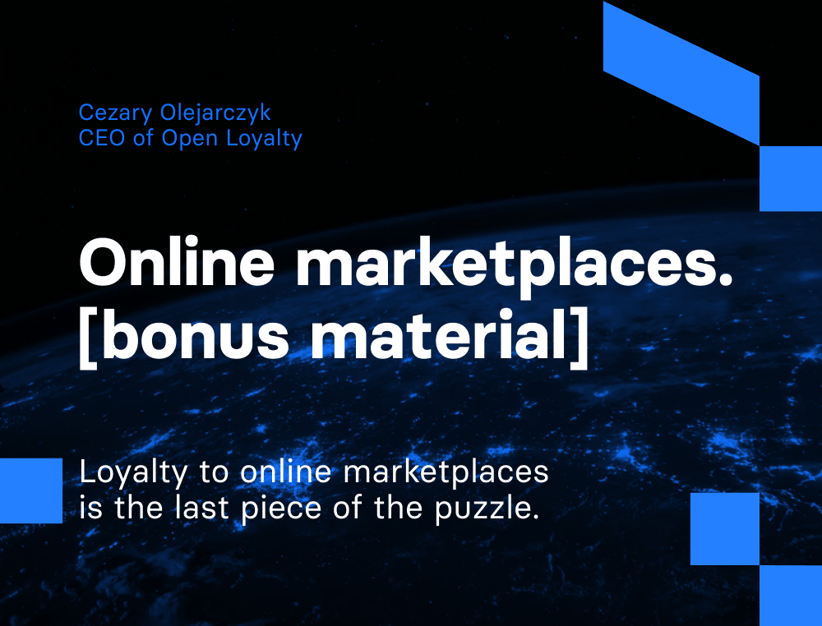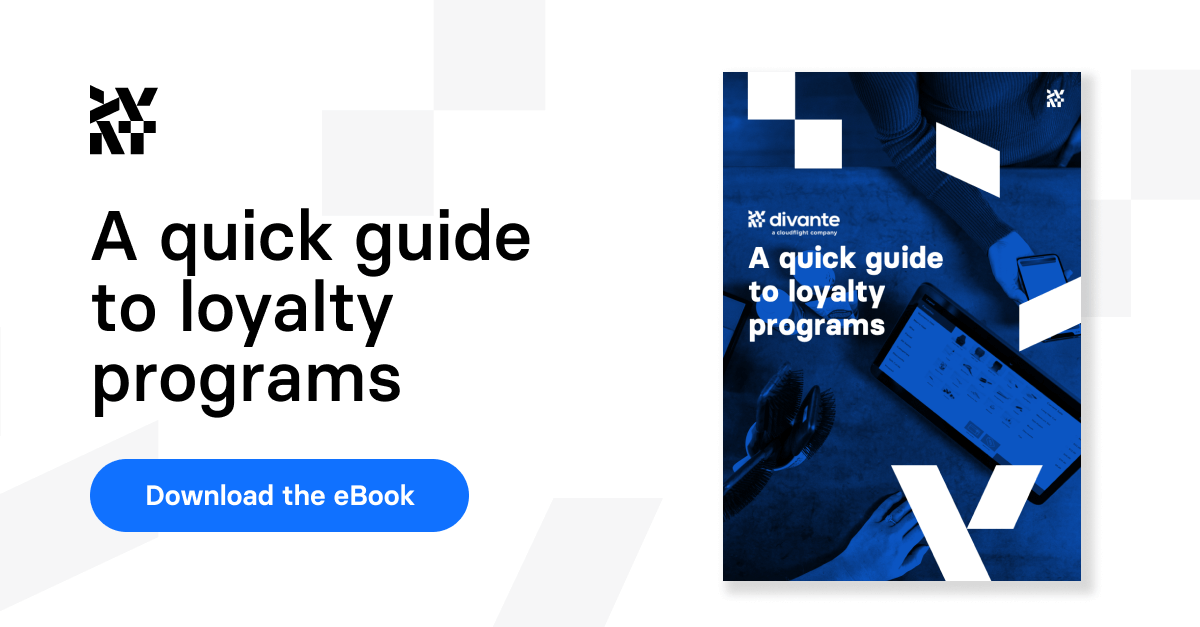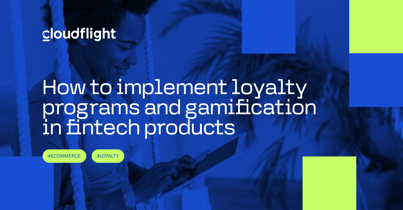As CEO of Open Loyalty, I was recently invited to contribute my thoughts on loyalty programs to the new ‘Guide to online marketplaces and how to build one’. It’s a comprehensive ebook that starts with the big picture of what an online marketplace actually is, and then narrows focus until it identifies the specific technologies you should use to build one.
As promised, I’ve since written an expanded version of my comments, which you can read here as a little bonus material to augment the ebook. I’ll be discussing how loyalty to an online marketplace may not seem intuitive or obvious. However, it is still quite possible to build brilliant customer-centric programs that benefit buyers, vendors, and the marketplace itself.
Cezary Olejarczyk, CEO of Open Loyalty
Loyalty programs are one of the best ways to build and maintain long-term client relationships. They work best when there is some form of financial reward but also when they can create an emotional reaction in customers. Businesses thrive over time when they can find ways to consistently deliver these two things. We all know how it can work in brick-and-mortar stores and we’ve seen it become a key element of online stores. However, marketplaces are the last great domain into which loyalty programs need to break. As with everything on a marketplace, if you can get it right, the rewards are huge.
Why is it hard to build loyalty in a marketplace?
Let’s start with a couple of hard truths. Firstly, marketplaces have traditionally found it difficult to build customer loyalty. People are bound by human relationships and there is something distant and impersonal about marketplace transactions. If you are buying on eBay or Amazon, the interface you are using to pay for goods is not even owned by the people you are buying from. In fact, customers may not even know or remember the name of the trader from which they are buying, as we naturally say “I bought it on Amazon”, not “I bought it from Mills and Scott of Wisbech”.
How is marketplace loyalty different from normal eCommerce?
A single-vendor eCommerce site is essentially just the same as a high street store. You only need to build one relationship, between the vendor and the customer. It may be digitized and data-driven but the essence of the loyalty program is no different to the relationship a high street butcher might have had with one of his regular clients in the 1950s. “Mrs Smith, for being one of my very best customers, I’ll put aside my prime cuts for you and give you free samples. I’ll also let you know in advance when I am getting special deliveries, give you first refusal on the best meat, round down the cost of your purchases a little, and throw in an extra pork chop now and again”. Exclusivity, emotional attachment, gated access to special products, tangible financial benefits… it has all the elements modern businesses aim to create in loyalty programs.
Loyalty for marketplaces is made more complicated by the fact that you have two clients to keep happy: the vendors who sell products on your platform and the end customers who buy goods from them. Giving to one party will naturally take something from the other, so implementing an easy-wins loyalty program is a challenge.

What are the most famous marketplace loyalty schemes? And why are they a bad example?
Marketplaces have long known that people struggle to feel an emotional attachment to their platforms but have looked for ways to create loyalty. On the face of it, Amazon Prime seems to be the ultimate example. Over half of households in America now use the service, ordering goods to a total value of more than $5 B USD. Prime is the first place that members go to shop but it is not a loyalty program—even if it claims to be one.
The important difference between loyalty programs and Prime is that you have to pay to become a member and there is no additional benefit beyond cut-price, fast shipping. In fact, at $10 per month, if users don’t make a minimum number of purchases to cover their outlay, the cost of membership will outweigh the benefit. What’s more, as with similar programs like Allegro Smart, membership can be canceled at any time. It’s not so much a loyalty program as it is a quid pro quo transaction, even if it does lead to greater retention and customer lifetime value.
What is an ideal loyalty program?
The best loyalty programs are those that replicate the personal touch of the old-time high street trader. Sephora is a good example. It has a tiered structure, meaning that anyone who signs up can benefit from basic discounts and closer communication with the brand. Regular customers then move up into the second tier in which they receive monthly gifts and a free custom makeover. Once members top $1000 a year in spending they move into the exclusive top tier in which they enjoy free shipping as standard, unlimited custom makeovers, event invitations, and even a private hotline to the store. The best loyalty programs are those that are able to give economic value but also create the emotional attachment that comes from feeling recognized–making people feel somehow special. Of course, they also create a sense of urgency and drive sales.
Can you create great loyalty programs for marketplaces?
If a good high street or e-store loyalty program is a win-win situation between the vendor and customer, then a great marketplace loyalty program is a win-win-win between marketplace owners, vendors, and customers. It can be difficult to calibrate at first but it is possible if vendors are convinced of the value and are willing to sign up. This is because, as the marketplace owner, you don’t own the goods you sell. You need the vendors to buy in and find ways that you can create value for clients together. And vendors will benefit from even greater volumes of sales… which is presumably why they sell through a marketplace in the first place.
How does a good online marketplace loyalty system look for customers?A loyalty program for online marketplaces is a coalition designed at giving repeat customers extra value. As a hypothetical example, Nike could partner with Zalando around the launch of a new Jordan shoe. They might:
– Offer 1,000 limited edition pairs in colors only available to Zalando loyalty scheme members
– Allow loyalty club members to buy shoes early, with guaranteed delivery on launch day
– Offer loyalty members who buy the new shoes a free pair of any previous editions of Jordan that are available on the marketplace
– And so on, ad infinitum
If we assume that the buyer is already interested in the product and perhaps even loyal to the manufacturer, the new bond we are creating is an emotional attachment to the marketplace which gave them a unique, exclusive offer that made them feel special.
How do vendors benefit from a marketplace loyalty program?
Someone has to foot the bill. If you are offering a discount or any freebies through a loyalty program, it has to be done in a strategic partnership with the vendor. The additional gains for the customer will come out of the profit margin of either the marketplace owner or the vendor. The marketplace may have a contract with new vendors in which they agree to run a certain number of marketplace-specific promotions each year. Or the marketplace itself may agree to cover the costs of promotions up to a certain value.
In reality, who covers the cost will always come down to who has the most to gain. In the case of our example with Zalando and the new Jordan shoes, Nike will be able to sell those anywhere at any price, so Zalando may feel it is worth covering the cost to be associated with such a huge event.
Of course, there is no one-size-fits-all loyalty scheme and marketplaces must experiment to find out what works with vendors. They also have to learn and adapt to what drives different customers, as some will be driven by the emotional experience of a loyalty program and their affiliation to a brand, while others will only be moved by the money they can save.
No matter how it is structured, the end result must always be the same for an online marketplace loyalty program to be brilliant:
– The marketplace needs to see an uplift in visitors and loyalty program members
– Vendors need to see a greater volume of sales and increased profits
– Most importantly, customers need to get tangible benefits and build deeper emotional connections with both brands
Published August 19, 2020














